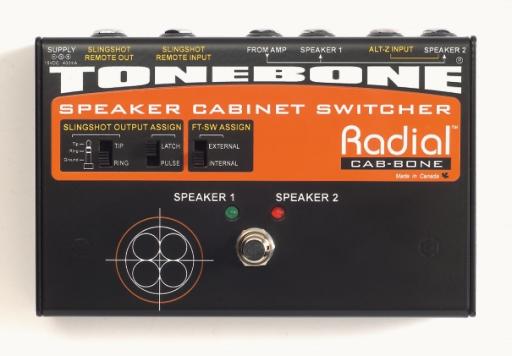MusicRadar Verdict
If your perfect rig includes more diverse cabinets than a back-street pawn shop, here's a cool way to hook them together and get some great sounds.
Pros
- +
Highly useful and versatile product that solves cab switching problems.
Cons
- -
Selectable impedance switches would have been a bonus.
MusicRadar's got your back
In the never-ending search for great tone, many guitarists have discovered the trick of using two or more different amp/speaker combinations and effects chains with dissimilar voicings to create wider and more varied sounds.
Listen carefully to recordings by ZZ Top, Led Zeppelin, Aerosmith, the Stones and many others, and you'll often hear at least two amps on guitar parts, adding all kinds of unique textures that just can't be achieved from one source.
It's one thing to experiment with an assortment of amps, effects and speakers in a studio environment, but quite another to transfer it to a live stage.
All of a sudden, the attendant problems of impedance and level matching, ground loops and portability cause far more hassle.
Of course, if you happen to play in a multi-platinum band the solution is simple: pay someone to sort it out.
Today, most modern pro guitar rigs use MIDI to activate relays, routing signals through different amps and loops, or changing settings on suitably-equipped amps like Mesa's new Stiletto head, often with custom intermediate level-matching preamps and impedance-matching isolation transformers to keep everything clean.
Serious systems like this are too expensive for most mortals. However, you can go a long way down the multiple amp/loop road using analogue switching, and three new products from Radial Engineering - the Head-bone, Loop-bone and Cab-bone - greatly expand your options.
All three switchers are housed in heavy steel boxes with clearly legible graphics to explain their functions. And to underline their pro standard they all come with a decent external power supply delivering a beefy 15 volts DC.
Overview
The Cab-bone allows one amp to switch between two speaker cabinets, using heavy duty fast relays and precision timing devices to ensure the amplifier always 'sees' a connected load.
There's also a useful dual impedance function, letting you connect different impedance cabinets to corresponding outputs on the same amp.
Why would you want to change cabs? Imagine swapping the focused mid-range punch of a closed back 4 x 12 for lead to the more open and undamped response of an open-back 2 x 12 for rhythm, or from a Celestion G-12 to an alnico Jensen.
Or perhaps you could combine conventional cabs with a real rotating Leslie speaker instead of a facsimile effect - remember, the loudspeaker is the last link in the audio chain and changing it has a fundamental effect on overall sound.
This box also has Radial's analog answer to MIDI - a clever remote switching function known as Slingshot.
Let's say you're on a big stage, you don't want a dozen different audio cables and power leads snaking underfoot if you can help it, so you can keep your Cab-bone close to your amps and connect it to separate switches using standard guitar leads.
Depending on the product, Slingshot can also be made to operate more than one device simultaneously.
In use
The unit behaved perfectly with no hum, no clicks and no pops, despite a pretty extreme test that involved repeatedly switching a Mesa Stiletto Deuce head running flat out via the Cab-bone into two 4 x 12s.
Radial's Slingshot concept makes perfect sense: we hooked the Cab-bone and Loop-bone (another Radial switching product) together so that switching effects loops changed the Stiletto's channels simultaneously at the same time as swapping speaker cabinets - all from just one button.
Designed and built to Radial's usual uncompromisingly high standards, this clever device brings pro-standard switching capability within reach of the dedicated weekend warrior for the first time.
It isn't cheap, but compared to off-the-peg alternatives from the likes of Skrydstrup, or a custom-made MIDI-powered rig from Pete Cornish or Bob Bradshaw, it represents excellent value for money with few readily available competitors.

“We were able to fire up a bass sound that was indistinguishable from the flavour of New Order’s Blue Monday in seconds”: EastWest Sounds Iconic review

“How long did it take me to get over it? Oh, quite a while”: Brian May on the “supreme injustice” of Roger Taylor’s Queen B-side "making as much money as Bohemian Rhapsody"

“Clem was not just a drummer; he was the heartbeat of Blondie. He was a source of inspiration both on and off the stage”: Clem Burke, drummer for Blondie, dead at 70









